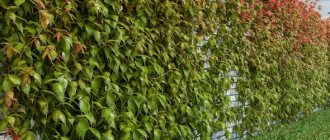Why do you need a trellis?
The vine is a woody vine that tries to “climb” to a high place, clinging to everything nearby in order to lift the shoots towards the sunlight. But it will be very inconvenient to pick grapes from the top of a tall tree at the dacha
When growing grapes at home, you need to control the development of the vine in order to increase its yield, simplify plant care, ripening and harvesting. If you don’t build a reliable support, the vine will begin to develop as it wants.
At the same time, if the vines are not fixed and remain on the surface of the earth, they will suffer greatly from pests and diseases, the berries and leaves will rot and be affected by mold fungi. To get a healthy and productive plant, it is imperative to use a strong columnar trellis.
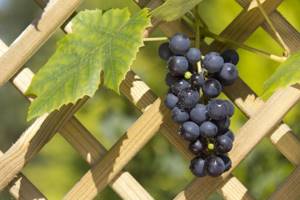
Grapes growing on a support are convenient to form correctly, easier to treat against diseases and to harvest ripe crops
What are grape trellises used for?
Grape bushes grow unhindered in the wild, produce fruit, and grow over large areas.
The plant climbs far due to competitiveness. Branches wrap around other trees and are located on fences. At the same time, resources are spent on growth. The berries turn out tasteless, low-juicy, and small. Part of the harvest is lost during rainfall. The branches lie on the ground along with the bunches, the berries rot and mold. The foliage suffers too. At home, the main goal is to get the maximum amount of grapes using small areas. Limiting the growth of bushes and their direction allows the plant to spend resources on fruits. Curly branches do not interfere with other inhabitants of the beds and do not shade the ground. Maintenance becomes simple. The support is made to protect the grapes from diseases and spoilage. Picking becomes easier, berries are removed from formed bushes faster.
Benefits of a Garter
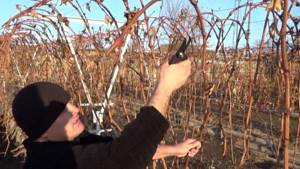
Strong supports allow you to control the direction and speed of shoot development, and fix vaccinations as needed by the gardener.
They make it possible to place the vines in sunny areas where the clusters are well illuminated by sunlight. They are blown with fresh air and dry quickly after dew or rain forms.
If you make a trellis, it will be easier to control the number of fruits, leaves and vines. Otherwise, if the load on the bush is incorrect, an environment is formed where the berries cannot ripen quickly and well, and the shoots will be overloaded and the plant will not have enough nutrients.
As a result, the plant will not have enough energy for the upcoming winter.
Structures and their purpose
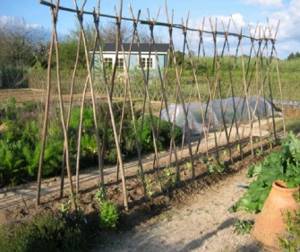
The simplest trellis on the site
There are many photos and videos of grape trellises that gardeners use, each with its own pros and cons:
- Single-plane vertical - the vines are tied in one plane
- Two-plane - 2 parallel useful planes are created, the stands are firmly fixed, shoots of one row of grapes are tied to a wire
- Gazebo - used in recreation areas. Decorative, uncovered grapes or climbing crops are mainly tied to them.
- Arched - allows you to get a high yield thanks to good ventilation and high-quality lighting of the vines. Arches allow you to create shade in the right place, but only frost-resistant grape varieties that do not require shelter can be grown on them
- Semi-arch – suitable for zoning a small area. Can be placed in a recreation area
- Pergola - used for shading; in addition to grapes, any liana-like plants are grown on them
| Type of support | Used for | Not suitable for |
| Single-plane | For areas with a lack of sunlight, plants receive maximum light there. For northern regions, in cold latitudes, it is easier to cover the grapes growing on them for the winter with millet by covering it with soil. You will need a little covering material, just attach it to the posts. For people who grow few grapes. Varieties with high shoot-forming ability are grown. | For powerful plants on which several branches are formed, since there is not enough space for new shoots and the bush quickly overgrows. |
| Biplanar | For plants with many shoots. For better fruiting. For fast growing varieties. For areas with good moisture and fertile soil. For standard plants. | For small areas that do not allow planting grapes separately. For areas with a lack of sunlight, in such conditions shoots tied in different planes are poorly lit. |
Types of trellises with photos
There are three main types of decorative supports for tall grapes: arch, gazebo and pergola.
Canopy
The arch perfectly holds the vine, and also decorates the site and in hot weather creates a shadow in which it is so pleasant to hide from the scorching rays of the sun.
Arched structures come in 2 types:
Semi-arch type canopy
- Semi-arched canopy. Most often, this option is used in areas where there is not much space. Here the plantings are combined with a recreation area, and the canopy provides protection from the sun. Grape bushes are planted in one row.
- Arched option. This type of arch is suitable for spacious areas with sufficient free space. In this case, the grape bushes are planted in two rows.
Alcove
A gazebo fits best in a small area. With its help, a vineyard and a cozy place to relax are connected in a small area. Often gazebos are placed in an open, well-lit place, which is perfect for growing heat-loving grapes.

Advice. For the gazebo, you can grow varieties with different ripening periods. This will allow you to harvest grapes throughout the season.
Pergola
A pergola is a structure of arches that are connected to each other by a lattice ceiling.
Pergolas fit perfectly into landscape design and do not take up much space. Most often they are installed above a bench, thus creating a cozy corner in the shade. All these trellises provide good lighting for the grape bushes, thanks to which they produce a bountiful harvest.
Required materials
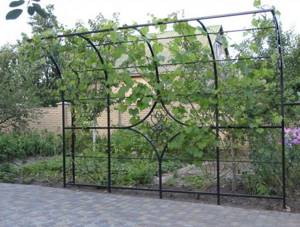
Metal trellis
Since the trellis is used to maintain the green mass of grapes, it must be as reliable as possible.
To make it with your own hands, use materials such as:
- High-quality lumber (without rot or other defects)
- Rebar and thick wire
- Metal grid
- Plastic and metal pipe
- Cement mortar

Trellis for grapes - rules of construction and installation
To make supports you will need several common tools:
- Wood hacksaw
- Grinder with metal discs
- Screwdriver
- Stapler
- Bayonet shovel
- Tape measure and building level
- Screwdriver and knife
Design selection
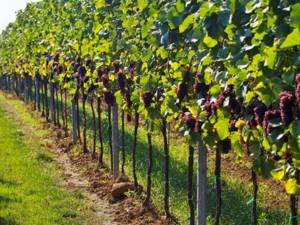
To make a trellis, according to step-by-step instructions, select the material and design of the support, taking into account the technical characteristics of the varieties and the nuances of their cultivation (resistance to diseases and low temperatures, possible yield)
They take into account both the place where the bushes will be planted and their financial capabilities. To save some money, use used materials; they can be purchased inexpensively at a scrap metal collection site.
For covering varieties, you should not use arches; if you need to get high yields, then you should not plant grapes near arbors. But for landscaping and for non-covering varieties, these structures are perfect.
Required dimensions
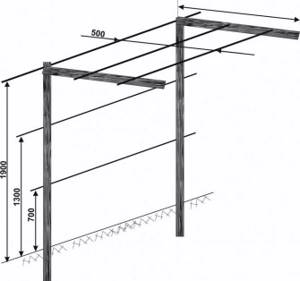
Typical drawing with dimensions
Trellis for grapes are installed according to the drawings before planting the seedlings. The supports are installed in advance according to the manufacturing instructions, because if the bushes grow for 1-2 years, then there is a risk of damage to the roots when installing the support posts.
Remember that you need to start pruning and shaping the grapes 2 seasons after planting. At this time, the future shape of the bush is created.
The optimal height of the trellis is 1.6-2.2 m from the ground, it is enough for convenient work and it allows you to cover plants for the winter. For the frame, according to the manufacturing instructions, it is permissible to use pipes with a diameter of at least 32-57 mm; it is advisable to use galvanized copper or stainless steel wire with a thickness of 2-4 mm, hanging it at intervals of at least 60 cm.
It is better to use hardwood with a cross section of 100-120 mm. You can use a 15x15 cm beam or a round log with the bark removed; their lower part is treated with resin or copper sulfate to provide protection from rotting. Wood should not be used for a two-plane support. Before use, the material must be treated with antifungal compounds, then it will last at least 7 years.
It is undesirable to make gazebos, arches and pergolas for grapes taller than 3.2 m; the high height of the vineyard makes maintenance work very difficult.
Single-plane support
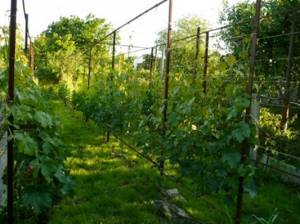
Support in one plane
The simplest trellis, formed in one plane - 2 support pillars are driven in and several parallel rows of wire are pulled or stapled onto them. The lower one is placed 60-100 cm from the soil, then after 30-40 cm, tie the growing grape vines to a stretched wire.
The pillars are constructed from the above materials. They are dug in 50 cm and the holes are filled with concrete, the outer pillars are reinforced with inclined beams. The height must be chosen taking into account your height, so that a person can reach the top wire. The supports need to be dug in every 2.5-3.5 m, leaving free row spacing of at least 2.5 m.
Pros:
- Simplicity and low cost of production
- Just reach any grape shoot. They are evenly spaced, easy to trim, collect ripe berries and cover the plants for the winter
- Plants are well lit and free ventilation is provided
Minuses:
- They cannot be used for vigorous varieties; the support may not withstand the growing foliage and green mass
- If the shoots are pruned incorrectly, the bush becomes overgrown and mold and mildew begin to develop on it.
How to make a single-plane trellis with your own hands
From the name it is clear that such a support consists of a single plane on which the vine develops. This is an example of the simplest support that is easy to create with your own hands. On a single-plane trellis, the plant receives a sufficient amount of air and lighting.
But there are several nuances that are worth considering before making such a support. Firstly, it involves not planting the crop too densely, which is only suitable for large areas. Secondly, such a structure is more suitable for technical varieties of grapes, but problems may arise with table varieties, since the peculiarity of this design does not allow the growth of tall shoots, and the berries located close to the ground are not of good quality. Therefore, a single-plane trellis should be chosen if you do not rely on a high yield.
1 – extreme support in the row; 2 – inclined post, which serves to strengthen the outer support; 3 – intermediate support in a row; 4 – wire or cable; 5 – fastening the wire to the support
The supports can be dug into the ground or concreted into the ground, as shown in the diagram. They usually reach about 2 m in height and are placed 3-4 m apart. Each of them must have holes for the wire, which must be stretched in several rows. The lowest row should be at a distance of 50-100 cm from the ground, and the second - 25-30 cm from it, since the lower grape shoots are usually the most fragile. Next, the rows of wire are placed at a distance of 40-50 cm from each other. But the topmost horizontal row should be at such a height that you can easily reach the vine with your hand.
V-shaped single-plane trellis. Another row arrangement option
For trellises, it is best to use galvanized wire with a thickness of at least 3-4 mm. The second option is a steel or metal-polymer galvanized cable in a PVC sheath.
Two-plane support
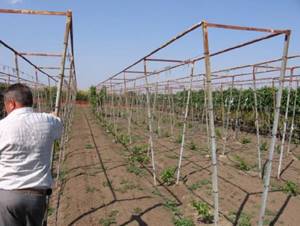
Two-plane trellis
There are many supporting structures in 2 planes; parallel U-shaped, T-shaped, Y-shaped and V-shaped trellises are more often used; the choice of a specific design depends on the needs of the winegrower. They are mainly used for vigorous varieties that can withstand low temperatures well.
The dimensions are the same as for single-plane supports. The height is about 2 m, the pillars are installed every 3-6 m, leaving a space between the rows of about 4 m.
As with any structure, biplane supports have their pros and cons:
Pros:
- Allows you to grow the most productive varieties
- The number of developing and ripening bunches increases
- Pollination of bunches under the influence of wind improves
- Saves free space in the garden - allows you to grow more bushes in a small area
Minuses:
- Only frost-resistant varieties can be planted, since covering plants for the winter is problematic and it is difficult to bend hanging vines to the ground surface
- Labor-intensive fastening of elements, more materials will be required
- Inability to reach all parts of the bush
Two-plane V-shaped
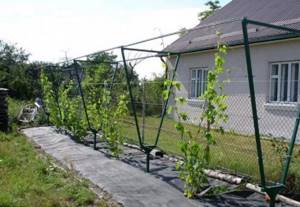
V-shaped support
A V-shaped support with 2 planes, structurally reminiscent of a single-plane trellis. It is recommended to dig two support pillars opposite each other at an angle of 45 degrees.
The pillars are welded together at the bottom and spread apart at the top.
Y-shaped
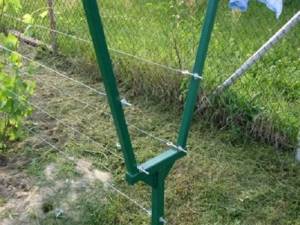
Y-shaped
It is better to use metal to build such a trellis for grapes. During manufacture, you will need welding equipment, and dig holes for concreting the base to a depth of at least 65 cm.
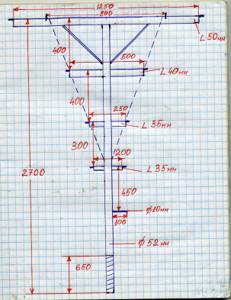
Visual drawing
When using profile pipes, you will need fastening elements such as crabs and top crossbars; when made from wood, it is better to use ash or oak; the work will require self-tapping screws and corners.
Decorative trellis
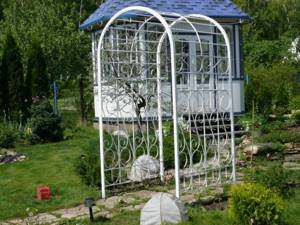
Decorative trellis
Decorative trellises were invented to organize recreation areas and shady places. Sometimes, to improve the design, they are placed along the walls of the house and the fences of the site. In this case, the presence of many leaves on the plants matters. They are often made from durable wooden slats, sometimes metal products are used, bending them in the form of semi-arches or in the form of visors.
Often wild grapes are grown on decorative structures, which do not require pruning and shaping; of course, in this case you will not get a harvest. But you only need to tie them up as the vines grow and water the grapes in time.
When did the trellis appear?
Initially, grapes were cultivated using trees as supports. However, already in ancient times, vineyards appeared on artificial supports - trellises.
In such vineyards, it has become easier to carry out green operations, restrain the wild growth of plants, pruning grapes has become easier, and it has become easy to maintain compact and convenient formations. The use of trellises in the vineyard made it possible to increase fruiting, and most importantly improve the presentation of the bunches and the taste of the berries, making harvesting easier, and losses from theft by birds and insects were minimized.
Pergola
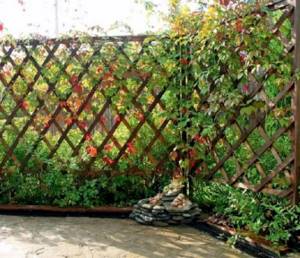
These designs are used if you need to organize a shaded, cozy corner on the site
They allow you to zone the territory and do not require much space. Grapes growing on a pergola are well illuminated by the sun, and the bunches ripen quickly, making it easy to remove excess shoots.
Such a support must be strong so that it does not break under the heavy weight of greens and berries. The wood used to make a pergola is strong and requires treatment with antiseptic compounds and bitumen; this must be done annually or the structure will need to be painted.
A pergola made of metal will cost you more; you will need a welding machine to operate it. Sometimes they make durable and beautiful forged products. Metal parts must be painted to protect them from rust. It is convenient to use a profile pipe; it is easy to bend and connect. The lower part of the structure is fixed with a solution mixed based on crushed stone, cement and sand.
Care for plants on the pergola in the usual way. Watering is carried out as necessary; fungi and diseases are treated in the summer. Winter-hardy varieties grow well on them, since the height of the structure is at least 2.5 m.
How to make a two-plane trellis with your own hands
This structure consists of two single-plane trellises located at a certain angle to each other. The height of the structure allows you to grow not only technical, but also table grape varieties on it, without limiting the growth of the plants. The obvious compactness, compared to a single-plane trellis, allows you to grow a larger number of plants without thickening the plantings. And placing the vine on an inclined plane provides it with protection from direct sunlight, which causes burns.
The other side of the “coin” is the greater complexity of the work when performing this design, and, accordingly, the financial costs of it. The second point is that caring for plants from the inside of this structure is much more difficult than if they grew on a single-plane trellis.
In terms of construction technology, height and distance between rows, the structure is almost identical to a single-plane trellis. The most popular option is V-shaped. Two posts are dug into the ground at an angle to each other, as shown in the diagram. Then they are fastened at the top with a transverse post, the length of which should be slightly greater than the upper distance between the posts. Exactly the same structure is made opposite, maintaining a distance equal to the planned length of the vineyard.
The wire is pulled in several rows. The distance from the ground to the bottom row, as in the case of the simplified version, should be at least 50 cm. Also provide a distance for a layer of mulch.
The second option is to dig one strong support into the ground and from it in opposite directions at the same angle, spread the base supports for the planes with obligatory fixation at the top using the same transverse post.
Arched trellis
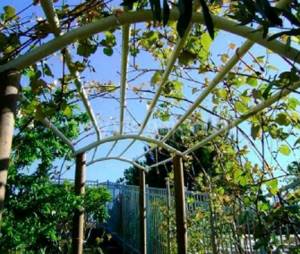
Arched trellis
It is convenient to use arches if there is a lot of free space on the site and you want to plant several varieties.
Remember that only frost-resistant varieties are used for growing on arches.
These structures are placed above the paths, and plants are planted on the sides. To make a trellis for grapes in the form of an arch, you will have to spend more money than for a simple support and will require a lot of work. Sometimes gardeners use a trick and place durable semi-arches near the walls of the building. This way you will get additional shade, but they can only be erected along the southern part of the house and the arch needs to be fastened to the wall.
The materials may be different, but it is important that it is durable:
- Metal profile (welding required for work)
- Plastic pipes (used only for small semi-arches; for larger sizes, plastic will not withstand the mass of shoots and a bountiful harvest)
- Lumber (impregnated with an antiseptic, the treatment is repeated every year), nails will be required for assembly
- Stretch a thick wire to tie the lashes
Arbor as a support for grapes
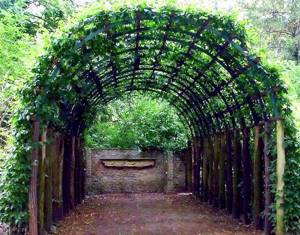
This is a decorative building on a summer cottage, but it is often used for growing frost-resistant grapes. Small furniture is installed in the gazebos
Decorative wild grapes are often planted along its walls. It is preferable to use a gazebo structure if you are building a tunnel-type building in the form of an arch or pergola.
How to build a pergola
Any suitable materials will be used.
The pergola consists of several U-shaped arches connected by a lattice ceiling. Here is an example of how to make a trellis for grapes: prepare sections of iron pipes with a diameter of 50-80 mm and a length of 2.5-2.7 m. For crossbars, you can take pipes with a diameter of up to 30 mm. An iron rod with a diameter of 12-18 mm is suitable to make a grate.
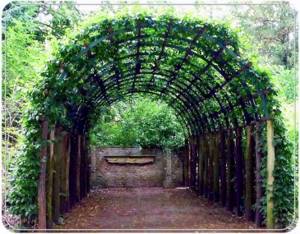
The supports are deepened by 50-60 cm, for which you need to dig a recess, secure the support in it with stones, crushed stone, broken bricks, or fill it with concrete to increase the reliability of the structure. Crossbars are welded onto the support posts, and a grid is installed no closer than 40 cm from the ground.
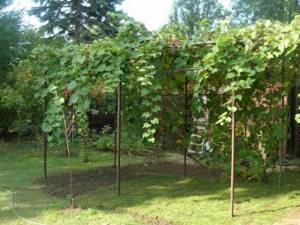
Plants are located on both sides of the pergola.
How to tie up vines
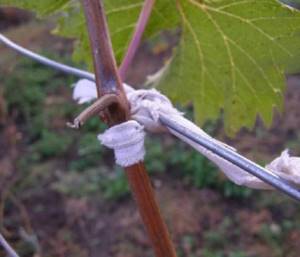
Garter vines
The grape shoots are tied up at the beginning of the sap flow, before the buds open. It is not advisable to tie up the vines later, otherwise many buds will break off during work, significantly reducing the amount of your harvest.
The nuances and subtleties of the methods of tying grapes to a trellis claim that when the shoots are placed in a horizontal direction or at a slight slope, more nutrients are supplied to the inflorescences, which helps to increase the clusters and the bush bears fruit better.
When the lashes are tied, the plants are fertilized and the trunk circle is dug up. Experienced winegrowers advise digging a small hole near the trunk, so that when watering, moisture will flow directly to the roots.
BEST Grape support. Drawing, dimensions. Two-plane trellis.
Trellis for gartering grapes: instructions with dimensions and drawings for making it yourself | (Photo & Video)+Reviews




